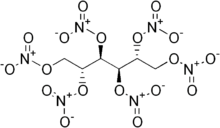Chemistry:Mannitol hexanitrate

| |
| Names | |
|---|---|
| IUPAC name
D-Mannitol hexanitrate
| |
| Systematic IUPAC name
(2R,3R,4R,5R)-Hexane-1,2,3,4,5,6-hexayl hexanitrate | |
| Other names
Mannitol hexanitrate
Nitromannite Nitromannitol Nitranitol Mannitrin | |
| Identifiers | |
3D model (JSmol)
|
|
| ChEMBL | |
| ChemSpider | |
| EC Number |
|
PubChem CID
|
|
| UNII | |
| |
| |
| Properties | |
| C6H8N6O18 | |
| Molar mass | 452.15 g/mol |
| Density | 1.73 g/cm3 |
| Melting point | 112 °C (234 °F; 385 K) |
| insoluble | |
| Explosive data | |
| Shock sensitivity | more sensitive than PETN, slightly below the line separating primary and secondary explosives |
| Friction sensitivity | comparable to PETN |
| Detonation velocity | 8260 m/s (@ 1.73 g/cm3) |
| RE factor | 1.70 |
Except where otherwise noted, data are given for materials in their standard state (at 25 °C [77 °F], 100 kPa). | |
| Infobox references | |
Mannitol hexanitrate is a powerful explosive. Physically, it is a powdery solid at normal temperature ranges, with density of 1.73 g/cm3. The chemical name is hexanitromannitol and it is also known as nitromannite, MHN, and nitromannitol, and by the trademarks Nitranitol and Mannitrin. It is more stable than nitroglycerin, and it is used in detonators.
Mannitol hexanitrate is a secondary explosive formed by the nitration of mannitol, a sugar alcohol. The product is used in medicine as a vasodilator and as an explosive in blasting caps. Its sensitivity is high, particularly at high temperatures (> 75 °C) where it is slightly more sensitive than nitroglycerine. Nitromannite is a class B explosive.
The production of pure MHN is not a trivial task, since most preparations will yield a mixture of MHN and lower esters (pentanitrate and lower).[1]
See also
- Pentaerythritol tetranitrate (PETN)
- Xylitol pentanitrate
- Erythritol tetranitrate (ETN)
- Ethylene glycol dinitrate
- Methyl nitrate
References
- ↑ Künzel, Martin; Yan, Qi-Long; Šelešovský, Jakub; Zeman, Svatopluk; Matyáš, Robert (2014-01-01). "Thermal behavior and decomposition kinetics of ETN and its mixtures with PETN and RDX" (in en). Journal of Thermal Analysis and Calorimetry 115 (1): 289–299. doi:10.1007/s10973-013-3265-2. ISSN 1388-6150.
- The Chemistry of Powder and Explosives, Tenney L. Davis
External links
 |

